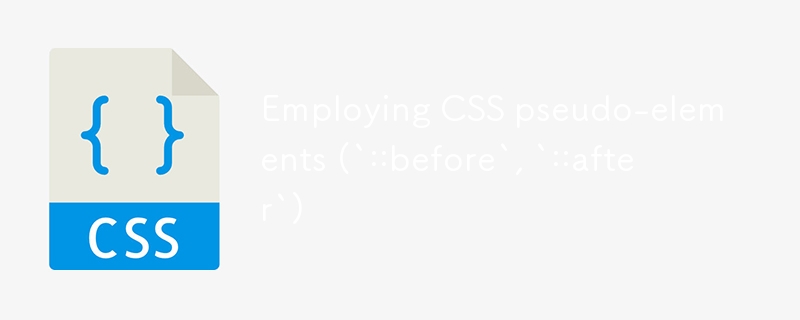Found a total of 10000 related content

How to set the bootstrap prompt box
Article Introduction:Bootstrap provides an information prompt box for elements. The settings are as follows: add data-toggle attributes and prompt text; load the Bootstrap JavaScript library; initialize the prompt box plug-in.
2025-04-07
comment 0
781

How to change the bootstrap prompt box
Article Introduction:Bootstrap prompt box styles can be customized according to specific needs, including modifying the color and background (such as: .tooltip { background-color: #f5f5f5; color: #333; }), position (such as: .tooltip { bottom: 0; left: 50%; transform: translate(-50%, 0); }), arrow style, font size and style, fade effect, and other customization options (such as modifying arrow size, inner margin, outer margin and limiting prompt box width).
2025-04-07
comment 0
360


How to write window function for vue
Article Introduction:In Vue, you can use window objects to access native JavaScript Window functions. Common functions include: window.alert(): display the warning box. window.confirm(): Display the confirmation box. window.prompt(): Show the prompt box. window.open(): Open a new window or tab. window.close(): Close the current window. window.location: Get or set the URL. window.history: Manage browsing history. window.screen: Get screen information. window.navigator
2025-04-08
comment 0
726

How to make form input fields mandatory using html attributes?
Article Introduction:The most direct way to make the input box in the HTML form required is to use the required property. This property is a Boolean type, and no value is required. It can be used to verify it on the input, select or textarea tags, such as:; Common matching types include text, email, password, etc.; for checkbox, directly add required to force check; in the radio button group, just add required to the first option; the select drop-down box needs to set the default empty value option to trigger verification; different browsers may have different styles and contents of prompt information. If a unified prompt effect is required, you can customize it with JavaScript or third-party libraries for customization.
2025-07-07
comment 0
775

What is the placeholder attribute in form inputs?
Article Introduction:The Placeholder property should display prompt information when the input box is empty when it is used for form input. Its main purpose is to improve the user experience through examples. First, display format examples in the input box, such as the phone number input box can display "(123)456-7890", and the user name input box can prompt "at least 6 characters"; second, it cannot replace the tag and verification function, and needs to be used with the tag to ensure accessibility; third, it is compatible with modern browsers. Old browsers such as IE9 and earlier versions do not support it, and can be processed through JavaScript fallback scheme; fourth, styles can be adjusted through CSS specific syntax, such as setting color and font style.
2025-06-22
comment 0
814


Adding placeholder text to input fields with HTML5 attribute.
Article Introduction:In web design, use the placeholder attribute of HTML5 to add prompt text to the input box. This property is directly added to the input or textarea tag, and the value is the prompt content, such as:. When the user clicks on the input box, the prompt text will automatically disappear. Notes include: 1. The placeholder is light in color and cannot replace the label tag; 2. It is not recommended to be used for important instructions, and some screen readers may not read; 3. Old versions of browsers such as IE9 and below do not support them, and they must be processed compatible; 4. The content should be concise and clear, avoiding vague descriptions or as required instructions; 5. The style can be adjusted through CSS, but it should not replace the verification prompt; 6. The mobile terminal may truncate the prompt text and must be kept short. Master these key points
2025-07-05
comment 0
667

Using the HTML5 `pattern` attribute for input validation regex.
Article Introduction:Using HTML5's pattern attribute allows for convenient front-end input verification without JavaScript. 1. The basic usage is to write regular expressions into the pattern attribute of the input tag, which is used to restrict the content of the text input box; 2. Regular expressions should be added to ^ and $ to ensure full match and avoid misjudgment; 3. It can provide clearer prompt information with the title attribute, but the mobile side may not display it; 4. Common application scenarios include verification of mobile phone numbers, postal codes, passwords, license plate numbers, etc., but back-end verification is still required to ensure data security.
2025-07-04
comment 0
285

How does the required attribute work for form validation?
Article Introduction:The required property is used to set the form field to be required, and the user cannot submit it if it has not filled in. 1. Add required attributes to HTML, without JavaScript; 2. It is often used with input types such as text, email, number, checkbox, radio, etc.; 3. The default prompt information of the browser cannot be customized, and JavaScript must be matched when a unified prompt is required; 4. Situations that may not work include: the submission button has formnovalidate attribute, the input box is disabled, the label structure is incorrect, or browser compatibility issues.
2025-06-28
comment 0
198

Creating tooltips with pure CSS
Article Introduction:The method of implementing tooltip with pure CSS is: 1. Use nested HTML structure to wrap the trigger area and prompt content; 2. Control the display and hide of child elements through:hover; 3. Use absolute positioning to set the prompt box position; 4. Add animation to improve the experience; 5. Pay attention to z-index and multi-directional adaptation. The specific implementation includes setting .tooltip as relative positioning, .tooltiptext is hidden by default, becomes visible when hover, and can add transition to achieve fading and delay effects. At the same time, positioning in different directions is controlled through class names, but it should be noted that the effect of hover on the mobile side may be limited.
2025-07-07
comment 0
214

How to validate a form with js?
Article Introduction:The key to form verification is to clarify the rules, reasonably bind events, and friendly prompt users. 1. Determine the fields to be verified, such as required items, format verification (email, phone number), and length limit (such as at least 8 digits of password); 2. Listen to the submit event through addEventListener and get the input value, and use e.preventDefault() to prevent the default submission; 3. Display error prompts. It is recommended to use elements to display specific information and clear the prompts when the input box gets focus; 4. You can combine HTML5 built-in verification attributes such as required, type="email", and minlength to improve compatibility, but it is still recommended to customize the prompts to maintain consistency.
2025-06-29
comment 0
364

How do I use the placeholder attribute to provide a hint to the user about what to enter in the input field?
Article Introduction:The placeholder property is used to display prompt text when the input box is empty, but it cannot replace label or form verification. Correct usage includes: 1. It must be used with label to improve accessibility; 2. Do not use placeholder to replace the required prompts, and should be combined with the required attribute; 3. Avoid placing too much explanation information in placeholder; 4. Set appropriate example text according to different input types, such as text, email, password and other input boxes.
2025-06-28
comment 0
502

Using HTML5 `` and `` elements
Article Introduction:HTML5 and tags can be used to achieve the collapsed effect without JavaScript; 1. It is a content container, hidden by default; 2. It must be located in the first child element as a title; 3. Common uses include FAQ, settings panel and information layered display; 4. You can customize styles through CSS, such as hiding arrows and adding animations; 5. Note that multiple cannot be nested, and browser compatibility needs to be considered.
2025-07-11
comment 0
723

Employing CSS pseudo-elements (`::before`, `::after`)
Article Introduction:Use CSS pseudo-elements (::before and ::after) to insert content and enhance visual effects without modifying HTML. 1. The basic usage is to add text or symbols through the content attribute, such as inserting red prompt text before the paragraph; 2. Common techniques include inserting quotes, arrows, icon fonts and implementing small triangles and other UI details; 3. You can use to match positioning and styles to achieve decorative effects, such as small triangles in the prompt box, button hovering effect, etc.; 4. It was used to clear floats, such as .clearfix::after to solve the floating collapse problem; 5. Notes include: the content must exist, the pseudo-element defaults to inline, and cannot be operated by JS, and is not suitable for placing important content, because of its influence.
2025-07-06
comment 0
865

Accessing User Location with HTML5 Geolocation API
Article Introduction:To obtain user location information, you must first obtain authorization. When using HTML5's GeolocationAPI, the first step is to request user permission. If the user refuses or fails to respond, an error should be handled and a prompt should be given; after successful authorization, the Position object includes coords (latitude, longitude, etc.) and timestamp; you can use watchPosition to monitor location changes, but you need to pay attention to performance issues and clear the listener in time. 1. Authorization requires the user to explicitly allow it to trigger the getCurrentPosition method request; 2. Process error.code when rejected or errored and prompt the user; 3. After success, position.coords provides location data; 4.watc
2025-07-07
comment 0
661

Get GeoLocation using jQuery (API) GeoPlugin
Article Introduction:jQuery easily get the visitor's geographic location
jQuery combines the GeoPlugin API to easily obtain the geographical location information of website visitors, including country, region, city, and latitude and longitude coordinates (can be used in Google Maps). This service is completely free! The following example contains a warning box that facilitates you to verify functionality:
How to use:
Copy the following jQuery code into the web page's tag.
Copy the following HTML code into the tag of the web page.
Run to view the effect!
jQuery code:
jQuery(document).ready(function($) {
alert("Your location: &quo
2025-03-05
comment 0
1143
















